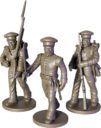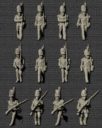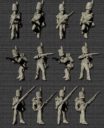Napoleonic Hanoverian Infantry: STL Kickstarter endet
David Vazquez Fernandez ist mit Hannoversche Infanterie auf Kickstarter unterwegs.
Napoleonic Hanoverian Infantry
Organization was on basically British lines, though with trained skirmisher sections (every twelfth man) rather than flank companies of British style; two of the regular battalions at Waterloo (Lüneburg and Grubenhagen) were ‘Light Battalions’ with all personnel thus trained. The Landwehr battalions each had four companies. Uniforms were largely of British style, in red (except for the green-clad light battalions and the Feldjäger corps), although the initial shortages in equipment evident when the army was first organized in 1813 may not have been overcome entirely, with continuing use of older uniforms and ‘stovepipe’ shakos.
https://www.napoleon-series.org/military-info/organization/c_hanlight.html
Field Jaeger Corps
Field Jaeger Corps was raised in 1813 of two and later 4 companies. Later under Colonel Friedrich, Count von Kielmansegge, it became known as the Kielmansegge Jaegers. It served with Count von Walmoden-Gimborn’s Corps in 1813/14 in the campaign against Hamburg [April and May], in Mecklenburg [June to November and saw action at the battle of the Gohrde [16 September1813], in Holstein [December-January 1814], Blockade of Harburg [January-March], campaign in the Netherlands [March-April]. In 1814 it became the Field Battalion of the Gottingen Regiment. It was disbanded in September 1814 at Hameln. In April 1815, it was reformed as two companies under Major August von Sporken. At Waterloo, it was in the 1st Hanoverian Brigade.
In the reorganization of the Hanoverian Army in 1816, it remained the Field Jaeger Corps.
Its uniform, according to Hofschröer, was green jacket, grey trousers and a field cap similar to the Prussian type.
Light Field Battalion Luneburg
Light Field Battalion Luneburg was raised in 1813. By June, it was commanded by Lieutenant Colonel August von Klencke. It served in a Light Brigade with Count von Walmoden-Gimborn’s Corps in 1813/14 in the campaign against Hamburg [April and May], in Mecklenburg [June to November] and saw action at The battle of the Gohrde [16 September 1813], in Holstein [December-January 1814], Blockade of Harburg [January-March]. It was stationed in the Netherlands 1814/1815 as part of the Hanoverian Subsidiary Corps, in the 2nd Light Brigade of the Light Division. At Waterloo, it was in the 1st Hanoverian Brigade. It was in France 1816-1818, in the First Brigade of the Hanoverian Corps of the Occupation Army. In 1814, it became the Field Battalion of the Luneburg Regiment. In the reorganization of the Hanoverian Army in 1816, it became the 1st Battalion [Luneburg Light Battalion] of the Luneburg Infantry Regiment.
Its uniform was based upon the uniform of the Light Battalions of the King’s German Legion: green jackets faced black with grey trousers.
Light Field Battalion Osnabruck
Light Field Battalion Osnabruck was raised in 1813/14 by Captain Heinrich von Anderten. In September 1814 it was renamed Field Battalion Duke of York [sometimes referred to as 1st Duke of York] It served in a Light Brigade with Count von Walmoden-Gimborn’s Corps in 1814 at the blockade of Harburg [January-March]. It was stationed in the Netherlands 1814/1815 as part of the Hanoverian Subsidiary Corps, in the 1st Light Brigade of the Light Division. At Waterloo, it was in the 1st Hanoverian Brigade. It was in France 1816-1818, in the First Brigade of the Hanoverian Corps of the Occupation Army.
In 1814 it became the Field Battalion of the Osbabruck Regiment (also referred to as Duke of York’s). In the reorganization of the Hanoverian Army in 1816, it became the 1st Battalion [Osnabruck Light Battalion] of the Osnabruck Infantry Regiment Duke of York.
I have no details of its uniform. Sichart states that the uniforms of the 5 Light Battalions were based upon the unifoms of the King’s German Legion and they wore green jackets.
Light Field Battalion Grubenhagen
Light Field Battalion Grubenhagen was raised in 1813 as the Harzer Schutzen [Sharpshooters] by Lieutenanty Colonel Carl von Beaulieu. By April 1814 it was known as Grubenhagen. It served in a Line Brigade with Count von Walmoden-Gimborn’s Corps in 1814 at the blockade of Harburg [January-March]. It was stationed in the Netherlands 1814/1815 as part of the Hanoverian Subsidiary Corps, in the 1st Light Brigade of the Light Division. At Waterloo, it was in the 1st Hanoverian Brigade. It was in France 1816-1818, in the First Brigade of the Hanoverian Corps of the Occupation Army.
In 1814 it became the Field Battalion of the Grubenhagen Regiment. In the reorganization of the Hanoverian Army in 1816, it became the 1st Battalion [Hoya Light Battalion] of the Hoya Infantry Regiment.
Its uniform was green jackets faced black and grey trousers.
British infantry center and flank companies
With all the previous figures plus the British, you can recreate Light Field Battalion Bremen-Verden, Light Field Battalion Calenberg and Light Field Battalion Lauenburg. All those who already have the previous project British Infantry or bought in the online store of course do not need the ALL IN since they are the same figures.
Stretch Goals:
Die Kampagne ist bereits finanziert und läuft noch 2 Tage.
Quelle: Napoleonic Hanoverian Infantry




























Kommentare